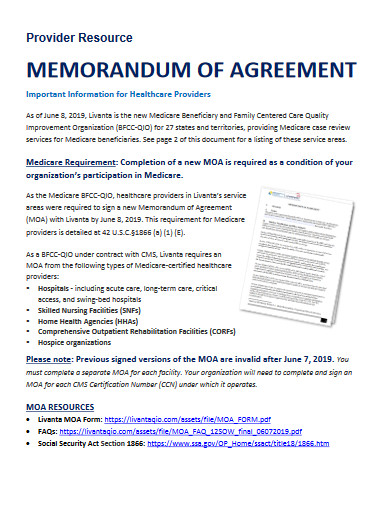

A business partnership or joint venture is one great way to ensure the success of a particular project. Whether in event sponsorship , construction project, and other undertakings, the arrangement has proven its benefits to almost all corporate entities. In line with that, a clear understanding of the business setting is a must to avoid complications between its partakers, so a memorandum of agreement (MOA) has to be produced. For example, in real estate, the agreement can be made to describe payments and other terms and conditions of the settlement to lease a property. Another good example is when retailers want to secure their bargains with product or service suppliers, highlighting commission among their other specifications. Below, you’ll get more examples to help you understand the memorandum of agreement even better.











An MOA is a legal document that defines and validates the collaboration between one organization with another to complete a business project. Just like a business partnership agreement, it holds complete details of the arrangement’s terms and conditions. According to AcqNotes, it is much more formal than a verbal agreement, but a little less formal than a contract. Its main purpose is to have proof that each of the participants is committed to fulfilling the obligations that one party has set and agreed upon by both. Because of its function, the legal risks are less likely to occur, but when they do, they can be dealt with easily.
Many people commit mistakes by interchanging an MOA to a memorandum of understanding (MOU). To make things clear, an MOA is different from an MOU. Here’s how.
1. By definition, MOA is the type of agreement that details two parties’ intentions to collaborate to reach a specific goal, while MOU is a document that only describes the terms of an agreement.
2. An MOA briefly discusses the partnership offer and its acceptance. On the other hand, MOU covers the offer and acceptance, at the same time, includes the project intentions and term considerations.
3. An MOA can be enforceable by the law, while an MOU can’t. However, the latter has some exceptions.
4. An MOA is always binding. In the case of an MOU, it can only be binding when the specifications involve money.
5. Both MOA and MOU are written documents. However, the former can also be made verbally, but not the latter.
Aside from making sure that your content is written clearly and concisely, you also have to ensure that it comprises thorough and standardized sections. For you to do so conveniently, we have provided you with a complete list of steps and insights below.
Since an MOA is obviously a formal business document, you have to create a cover page. In it, the founding company logo, document title, legalization date, and a short confidentiality statement should be included. The purpose of creating one is to convey what the enclosed document is about at a glance.
As you go over with your MOA’s content, start by giving out the main reason why it is created. Along with it, the name of the involved parties, brief description of the scope of work, the effectivity date, and the contact information of the involved parties have to be entered.
Each of the MOA’s participants has obligations to fulfill to achieve a shared goal. Enumerate them all to make sure that the both stakeholders are well-guided in what activities to implement and when to implement them. Needless to say, a schedule of work is necessary in this section.
Most business partnerships come with monetary exchange. Because of this, you have to include in your outline of sections the payment specifications. Just like the previous step, you have to produce a schedule, specifically a payment schedule. However, this section can also be excluded if it’s not applicable, like situations where the business partnership takes the form of sponsorships.
Every agreement or contract has a duration. It is very important that you indicate how long the MOA will continue its effect after it was carried out to let concerned audiences know if the terms are still applicable or not. The duration has no specifics and merely depends on the involved parties. It could be for a week, month, or even years.
There are various reasons why an agreement has to be terminated. They could be because the responsibilities are too much to handle or maybe because of fraud or misrepresentations, illegality, and breach. Whichever case may take place, the actions according to the founding party’s dispute resolution policy has to be cited.
To seal the agreement, both parties have to imprint their respective signatures. By fixing them, all the participants acknowledge the details provided in the agreement and verify their assent to them.
A misrepresentation is an unlawful act where the criminal provides misleading or untrue information to one party during a transaction. This often occurs in the provisions of agreements, contracts, as well as in advertising and marketing materials.
Disputes are expected in agreements or contracts. They can be resolved in three ways, including the following:
1. Mediation – a neutral third party encourages contract or agreement participants to talk about the lapses and try to resolve them on their own
2. Arbitration – a neutral third party listens to both sides’ discourse and looks into pieces of evidence to come up with a fair decision criteria
3. Litigation – a judge or a jury will take over the responsibility of the neutral third party and decides according to his or her expertise in legal practices
There are four types of business partnerships. They consist of the general partnership (GP), limited partnership (LP), limited liability partnership (LLP), and limited liability limited partnership (LLLP).
There is always a risk when companies engage in a transaction with other organizations. Even though trust is crucial in business partnerships, we can all agree that proofs are necessary just in case such a trust fails them. This is why as part of a documentation procedure , documentation plan , or documentation procedure , a MOA has to be produced.